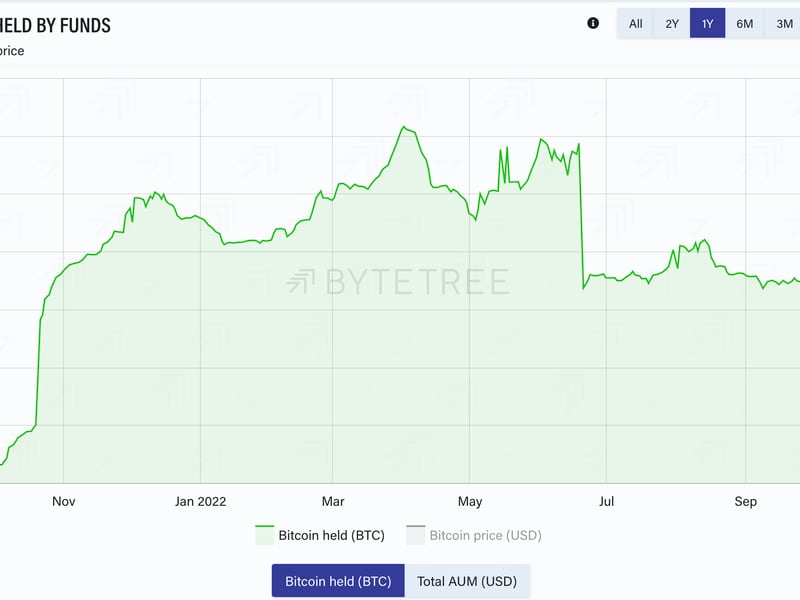Bitcoin Stays Resilient in Face of Traditional-Market Turmoil, Here's Why

Bitcoin has outperformed almost every traditional asset in recent days. Observers said the cryptocurrency has stayed resilient to renewed turmoil in traditional markets due to several factors, including the absence of large sellers, continued holding by long-term investors and quarterly options expiry.
Since the Federal Reserve raised U.S. borrowing costs by 75 basis points a week ago, the dollar index has rallied 4% while the S&P 500 has dropped by 6.4% and the British pound has crashed to an all-time low against the greenback. Bitcoin, however, has remained locked between $18,000 and $20,000.
"I think what we're seeing is more a lack of large sellers, rather than a plethora of large buyers," Mike Alfred, a value investor and founder of digital assets investment platform Eaglebrook Advisors, said. "There are no large sellers left. Forced selling has already occurred."
Alfred said bitcoin is not structurally correlated to traditional assets like stocks, bonds, and the dollar index over long periods. That means there is no reason to keep selling the already battered cryptocurrency even as traditional markets swoon.
Bitcoin peaked at $69,000 in November and has been heading generally lower ever since. The price slid 56% in the second quarter alone as Terra collapsed, destroying billions of dollars in investor wealth.
Large market participants appear to have stopped selling, as evidenced from the relatively consistent number of bitcoin held by funds.

Data tracked by ByteTree Asset Management shows the number of coins held by the U.S. and Canadian closed-ended funds and Canadian and European exchange-traded funds (ETFs) has ranged between 833,000 BTC and 842,000 BTC since mid-June.
According to blockchain analytics firm Glassnode, bitcoin's relative stability stems from the "full detox of speculative interest" and long-term investors refusing to cave in and sell in a weak macroeconomic environment.
"The dominance of mature coins being spent has collapsed from an exuberant 8% at the height of the bull in Jan 2021, to a distribution of just 0.4% of all volumes," Glassnode's analysts wrote in the latest edition of the firm's weekly newsletter. "This suggests that the cohort of investors with older coins remain steadfast, refusing to spend and exit their position at any meaningful scale."
Glassnode defines mature coins as those that have remained dormant for at least six months.
Griffin Ardern, a volatility trader from crypto asset management firm Blofin, said the quarterly options expiry, due this Friday, might also be helping the cryptocurrency stay relatively resilient.
"Ahead of the expiry, the spot price tends to be as close as possible to the max pain," Ardern said, adding that the max pain for bitcoin is $22,000.
The max pain is the strike price at which the most open options contracts expire worthlessly. According to theory, the max pain point acts as a magnet for spot prices as expiration approaches because option sellers, mostly institutions, sometimes try to push prices closer to the max pain to inflict maximum loss on options buyers.
One theory is that the recent decline in fiat currencies like the Chinese yuan, British pound and the Japanese yen may have spurred demand for bitcoin. In the past, Chinese investors have taken the crypto route to move money into overseas assets to bypass domestic regulation and currency devaluation.
While it's difficult to prove that the European investors are doing the same right now, circumstantial evidence supports the narrative.
"Flows into digital asset investment products remained tepid last week ($8.3 million), but with some notable regional differences," Ilan Solot, a partner at Tagus Multi-Strategy Fund, said in a daily market update. "North America saw $9.4 million of OUTflows, while Europe saw $15 million of INflows. Could this be the first clue to the recent resilience in crypto markets? Too soon to say."
#Bitcoin volumes against #GBP were US$881m yesterday (US$70m average), when a FIAT currency is threatened, investors start to favour Bitcoin pic.twitter.com/Q3pXJTDHWZ
— James Butterfill (@jbutterfill) September 27, 2022
While bitcoin has managed to stay resilient so far, its immediate prospects remain tied to macro factors and traditional markets. In other words, the cryptocurrency remains vulnerable to a deeper sell-off in the S&P 500, rising yields and continued dollar liquidity squeeze.








